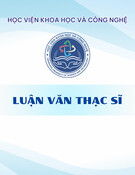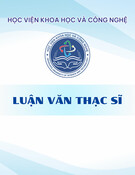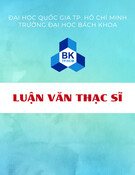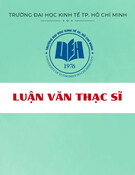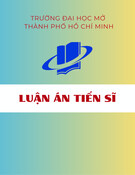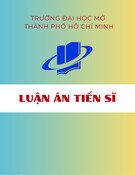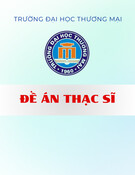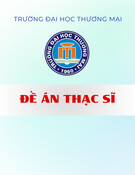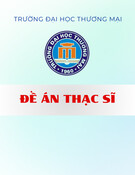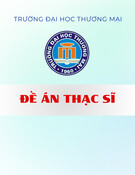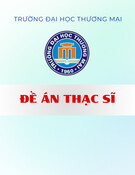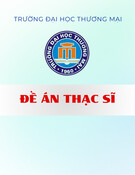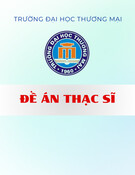VIETNAM NATIONAL UNIVERSITY, HANOI
UNIVERSITY OF LANGUAGES AND INTERNATIONAL STUDIES
FACULTY OF POST-GRADUATE STUDIES
******************
NGUYỄN THỊ LINH
IMPACTS OF VIETNAMESE STANDARDIZED TEST OF ENGLISH
PROFICIENCY (VSTEP) ON THE FIRST YEAR STUDENTS’ ENGLISH
LANGUAGE LEARNING AT UNIVERSITY OF LANGUAGES AND
INTERNATIONAL STUDIES (ULIS), VIETNAM NATIONAL
UNIVERSITY, HANOI (VNU)
(NHỮNG TÁC ĐỘNG CỦA KÌ THI CHUẨN HÓA ĐÁNH GIÁ NĂNG LỰC
TIẾNG ANH THEO KHUNG NĂNG LỰC NGOẠI NGỮ 6 BẬC DÙNG CHO
VIỆT NAM (VSTEP) TỚI VIỆC HỌC TIẾNG ANH CỦA SINH VIÊN NĂM
NHẤT TRƯỜNG ĐẠI HỌC NGOẠI NGỮ, ĐẠI HỌC QUỐC GIA HÀ NỘI)
M.A. MINOR PROGRAMME THESIS
Field: English Teaching Methodology
Code: 60140111
Hanoi, 2016
VIETNAM NATIONAL UNIVERSITY, HANOI
UNIVERSITY OF LANGUAGES AND INTERNATIONAL STUDIES
FACULTY OF POST-GRADUATE STUDIES
*******************
NGUYỄN THỊ LINH
IMPACTS OF VIETNAMESE STANDARDIZED TEST OF ENGLISH
PROFICIENCY (VSTEP) ON THE FIRST YEAR STUDENTS’ ENGLISH
LANGUAGE LEARNING AT UNIVERSITY OF LANGUAGES AND
INTERNATIONAL STUDIES (ULIS), VIETNAM NATIONAL
UNIVERSITY, HANOI (VNU)
(NHỮNG TÁC ĐỘNG CỦA KÌ THI CHUẨN HÓA ĐÁNH GIÁ NĂNG LỰC
TIẾNG ANH THEO KHUNG NĂNG LỰC NGOẠI NGỮ 6 BẬC DÙNG CHO
VIỆT NAM (VSTEP) TỚI VIỆC HỌC TIẾNG ANH CỦA SINH VIÊN NĂM
NHẤT TRƯỜNG ĐẠI HỌC NGOẠI NGỮ, ĐẠI HỌC QUỐC GIA HÀ NỘI)
M.A. MINOR PROGRAMME THESIS
Field: English Teaching Methodology
Code: 60140111
Supervisor: Tô Thị Thu Hương, PhD
Hanoi, 2016
DECLARATION
I hereby declare that my thesis submitted for the Faculty of Post-Graduate
Studies, University of Languages and International Studies, Vietnam National
University has been composed by myself, apart from the help recognized. This
paper has also not been submitted for any other degree or processional qualification
except as specified.
Hanoi, 2016
Ngu n Thị Linh
i
ACKNOWLEDGEMENT
I would like to send my thanks to many individuals for their invaluable help
during the conduct of the research. Without their help, the completion of this
research project would not have been possible.
First and foremost, I would like to express my special appreciation and
thanks to my supervisor, Dr. To Thi Thu Huong for her remarkable supervision,
enthusiastic guidance, invaluable support and critical feedback throughout the
research.
Besides my advisor, I would like to thank all the doctors and lecturers of the
Faculty of Postgraduate Studies, University of Foreign Languages and International
Studies, Vietnam National University, Hanoi for their useful lectures, which are
partly applied in this study.
Next, I wish to send my big thanks to the first year students at University of
Languages and International Studies (ULIS), Vietnam National University, Hanoi
(VNU) for their cooperation and the valuable information they provided in my
research questionnaire.
Furthermore, I would like to give my heartfelt thanks to my family and
friends, especially my mother, for standing by me and for giving me their
unconditional love, care, good assistance and patience.
Finally, my sincere thanks also goes to graders and readers for their valuable
evaluation and feedback on this thesis.
ii
ABSTRACT
Due to the globalization of the English language, a global testing campaign
has been established, specially standardized English proficiency tests. According to
Templer (2004), these tests have increasingly controlled access into privileged
educational and occupational paths in the professional and corporate world, and
affected many local language policies. In Vietnam, a new national English test - the
Vietnamese Standardized Test of English Proficiency (VSTEP) applied at the
University of Languages and International Studies (ULIS), Vietnam National
University, Hanoi (VNU) and other schools has gradually assumed a greater gate-
keeping role. This paper aims to investigate the impacts of the VSTEP as a
graduation requirement on the first year university students‟ English learning at
ULIS. The paper begins with some background information about English
language‟s role and certification exit requirements. The next section discusses the
context that induced the introduction and implementation of the policy of using
VSTEP certificates to determine graduation eligibility. The main part of this paper
examines in detail the impacts of the VSTEP test on the learning of English of the
first year students at ULIS. Finally, the discussion section evaluates the efficiency
of the policy, followed by some recommendations.
iii
TABLE OF CONTENTS
DECLARATION .................................................................................................... i
ACKNOWLEDGEMENT..................................................................................... ii
ABSTRACT ..........................................................................................................iii
TABLE OF CONTENTS ..................................................................................... iv
LIST OF TABLES ................................................................................................ vi
LIST OF ABBREVIATIONS ............................................................................. vii
CHAPTER ONE: INTRODUCTION .................................................................. 1
1.1. The English language education in Vietnam ........................................... 1
1.2. Rationale of the study ............................................................................... 2
1.3. The significance of the study .................................................................... 2
1.4. Aims of the study ...................................................................................... 3
1.5. Research questions of the study ............................................................... 3
1.6. Organization of the study ........................................................................... 3
CHAPTER TWO: LITERATURE REVIEW ...................................................... 5
2.1. The VSTEP ............................................................................................... 5
2.1.1. The introduction of the VSTEP as an English certificate exit requirement at ULIS. .................................................................................... 5
2.1.2. The basic information of the VSTEP levels 3-5 ................................ 6
2.2. Definition of impact and related studies ................................................ 11
2.3. Impacts of some English tests as a graduation requirement ................ 16
CHAPTER THREE: METHODOLOGY .......................................................... 20
3.1. Introduction ............................................................................................ 20
3.2. Method of the study ................................................................................ 20
3.3. Context of the study ............................................................................... 21
3.4. Participants ............................................................................................. 21
3.5. Data collection instrument ..................................................................... 22
3.6. Data collection and analysis procedures................................................ 26
CHAPTER FOUR: FINDINGS AND DISCUSSION ........................................ 28
4.1. Some general information about the first-year students. ........................ 28
Table 7: Students’ general information .................................................................. 28
4.2. Impacts of the VSTEP on students’ English learning ............................. 30
iv
4.2.1. Academic impacts: Learning Content and Learning Methods ........ 30
4.2.2. Affective impacts: goal orientation, motivation, self-efficacy and anxiety .......................................................................................................... 34
CHAPTER FIVE: CONCLUSION AND RECOMMENDATIONS................. 42
REFERENCES .................................................................................................... 45
APPENDIX 1 ......................................................................................................... I
v
LIST OF TABLES
Table 1. Format of the VSTEP................................................................................ 7
Table 2. VSTEP level conversion table .................................................................... 9
Table 3. VSTEP equivalency table ........................................................................ 10
Table 4: Structure of the questionnaire .................................................................. 23
Table 5: Changes of some items in the edited questionnaire compared to original version. .................................................................................................................. 24
Table 6: Changes of some items between pilot and main questionnaire ................. 26
Table 7: Students‟ general information .................................................................. 28
Table 8. Impact of the VSTEP on students‟ learning content ................................. 30
Table 9. Impact of the VSTEP on students‟ learning methods ............................... 33
Table 10. Impact of the VSTEP on students‟ goal orientation ................................ 34
Table 11. Impact of the VSTEP on students‟ motivation ....................................... 35
Table 12. Impact of the VSTEP on students‟ self-efficacy ..................................... 38
Table 13. Impact of the VSTEP on students‟ anxiety ............................................. 39
vi
LIST OF ABBREVIATIONS
VSTEP: Vietnamese Standardized Test of English Proficiency
ULIS: University of Languages and International Studies
VNU: Vietnam National University, Hanoi
MOET: Ministry of Education and Training
TOEIC: Test of English for International Communication
TOEFL: Test of English as a Foreign Language
CEFR: Common European Framework of Reference for Languages
DA2020: Đề Án Ngoại Ngữ Quốc Gia 2020
EFL: English Foreign Language
ASL: Arabic Second Language
HKCEE: Hong Kong Certificate of Education Examination
NMET: National Matriculation English Test
GEPT: General English Proficiency Test
FCE: First Certificate in English
IELTS: International English Language Testing System
CET: College English Test
vii
CHAPTER ONE: INTRODUCTION
1.1. The English language education in Vietnam
As mentioned by Hoang (2011), English test is one of the six national exit
exams at Junior and Senior Secondary School and English is studied as a
compulsory subject by 94% undergraduates and 92% graduates at Vietnamese
institution. However, the teaching activities in classes are not delivered in an
effective way for students to achieve sufficient levels of competence to pass the
certifications required for recruitment. Ha (2007) also argues that the level of
communicative competence in English of most Vietnamese employees are still very
low, and many freshly graduated students cannot get jobs in foreign companies
because of the English language requirements. The fact is that most Vietnamese
learners still cannot use it effectively as a means of communication after a long
period of learning English. Pham (2004) estimated that in a class of fifty English
major learners, fewer than ten graduates have the sufficient English skills for jobs
such as interpreters, translators, tour guides or teachers of English. Moreover,
according to Ellis (1996) and Pham (2004), English classrooms in Vietnam continue
to focus more on grammar-oriented than communicative.
The current issues point to the fact that Vietnam should upgrade the currently
low English teaching and English use standards in order to catch up with the fast
globalisation process, sizable inputs and major changes. An innovation has been
proposed in order to ensure higher standards of English proficiency among students
graduating from Vietnamese tertiary institutions. One of the main goals of the
“National Foreign Languages Project to the year 2020” (DA2020) is to strengthen
students‟ English proficiency throughout the educational system. A key feature of
this English project is to impose graduation standards control; that is, to require
graduates to achieve certain minimum standards before they could graduate from
their study programmes. Therefore, in early 2008, Vietnamese Ministry of
Education & Training (MOET) gave an official instruction, requiring universities
1
and colleges to articulate their graduation standards, among which is the English
requirement, by the end of the same year.
1.2. Rationale of the study
Since August 15th, 2015, ULIS-VNU has used the VSTEP as an exit test for
all students. This proficiency test is completely new in Vietnam and there has no
study on this. Therefore, I would like to conduct this study in order to explore its
impact on students‟ English learning at ULIS.
Students at ULIS have to achieve certain level of the VSTEP required by the
university before graduation. Therefore, the test would have certain impacts on
their learning. Among students at different years, the first year students are those
who just enter a new learning environment. The transition from high school to
higher education is considered the most stressful period for the first year university
students. Adapting to the new environment makes them experience many
unexpected circumstances. Different workload such as assignments, varied teaching
methods, and working with other students and lecturers are some examples of these
unexpected circumstances. Thus, knowing the impact of the test on the first year
students‟ learning of English would be helpful to both lecturers and students in their
teaching and learning.
As mentioned before, the VSTEP is a new test, so an investigation of its
impacts on students‟ learning of English at ULIS-VNU could be seen as an example
of research on test impact, which has become a significant area of interest in
language testing in recent years.
1.3. The significance of the study
This is a small-scale empirical study of test impact in Vietnam. It is one of
the first studies exploring the impacts of the VSTEP - a new English proficiency
test in Vietnam, so this study would fill in the research gap on the VSTEP. The
study is potentially significant in that it provides an insight into the impact of an
exit test on English language learning in University of Languages and International
2
Studies (ULIS). Most importantly, the study highlights the voices of students, the
very people at the centre of the learning process.
The findings of this study should provide some important information to help
the institution; on the other hand, to further improve the test itself for more
beneficial impacts, i.e to enhance English teaching and learning through the design
and administration of the test and to improve the policy and implementation of the
English graduation requirement.
1.4. Aims of the study
This study was conducted to investigate the impacts of the VSTEP on the
first year students‟ language learning at University of Languages and International
Studies (ULIS) – Vietnam National University (VNU). Following the study of
Hongli Li, Qi Zhong and Hoi K Suen (2012), the researcher would like to
investigate the impact of VSTEP on ULIS students‟ English learning in two ways:
academic and affective. The academic impact refers to the VSTEP‟s influence on
“students‟ English - learning behavior, as this pertains to learning content (i.e., what
students study) and learning methods (i.e., how they study)”, whereas affective
impact refers to the VSTEP‟s influence on “students‟ affective conditions, such as
goal orientation, motivation, self-efficacy, and anxiety.” (Hongli Li, Qi Zhong and
Hoi K Suen, 2012: 82).
1.5. Research questions of the study
Research question 1: How does the VSTEP influence the students’ English
learning behavior in terms of learning content (i.e., what students study) and
learning methods (i.e., how they study)?
Research question 2: How does the VSTEP influence the students’ affective
conditions such as goal orientation, motivation, self-efficacy, and anxiety?
1.6. Organization of the study
The study consists of 5 chapters
Chapter 1: Introduction of the research
Chapter 2: Literature review (Other researches on this topic are discussed)
3
Chapter 3: Methodology (the way the researcher collected the data as well as
analysis them is showed)
Chapter 4: Findings and discussion
Chapter 5: Conclusion and recomendations
4
CHAPTER TWO: LITERATURE REVIEW
2.1. The VSTEP
2.1.1. The introduction of the VSTEP as an English certificate exit
requirement at ULIS.
It has been obvious that many tertiary institutions integrated graduation
standard control into study programmes which was essential for assuring the quality
of institutions‟ qualifications. There have been several means to achieve the goal.
Most universities in Vietnam adopted standardized English proficiency tests such as
Test of English for International Communication (TOEIC) and Test of English as a
foreign language (TOEFL), either self-developed tests or external public tests, as
the means of standards control. ULIS is an example of this policy. The institution
has newly applied a national English proficiency test called Vietnamese
Standardized Test of English Proficiency (VSTEP) and required all the students to
submit evidence of the required English level measured by the VSTEP for
graduation.
The VSTEP is a standardized test designed to measure the English
proficiency of undergraduate students at ULIS. The test is based on the Common
European Framework of Reference for Languages (CEFR) and be relevant to the
context of English use in Vietnam. Students are expected to take the VSTEP from
the end of their second year till the last year at ULIS. The VSTEP are held several
times a year; therefore, students can take the test many times while at the university.
The test targets level 3 to level 5. The students of ULIS need to achieve level 5
which is equivalent to the level C1 of the CEFR test. Like most of the CEFR - based
test, VSTEP consists of four sections: listening, reading, writing and speaking. The
innovation - setting the VSTEP as a graduation requirement – is expected to have
impacts on what and how teachers teach and what and how students learn, thereby
promoting students‟ English skills development.
5
2.1.2. The basic information of the VSTEP levels 3-5
2.1.2.1. The origin of the VSTEP
It is clearly that English has played a predominant role in the foreign
language teaching program at tertiary level in Vietnam for a long period (Hoang
Van Van, 2008). In 1986, opening the door of Vietnam to the world and under the
impact of globalisation and internationalisation in higher education lead to the
demand for enhancing English language teaching and learning which is one of the
most important purposes of higher education renovation in Vietnam. The
Vietnamese government also seems to prioritise this goal when it officially adopted
the Common European Framework of Reference for Languages (CEFR) as the
national framework of reference for foreign language education in Vietnam in 2008
under Decision 1400/QĐ-TTG. Decision 1400/QĐ-TTG is to approve DA2020 and
one of the duties of the DA 2020 is to design and apply a tool for assessing English
proficiency of Vietnamese students.
Therefore, linguists and educators created a local CEFR-V; that is, a
Vietnamese version of the Common European Framework of Reference for
Languages, a set of standards used in teaching English in Vietnam. According to Circular No. 01/2014 / TT – 01- Ministry of Education & Training on January 24th,
2014, Minister of Education and Training has issued the Vietnameses Standardized
Test of English Proficiency (VSTEP) for levels from 3 to 5. It is applied to foreign
language training institutions, language training, and language learning in the
national education system.
2.1.2.2. The format of the VSTEP
There are four parts in the test:
Part 1: Listening _40 minutes
Part 2: Reading _60 minutes
Part 3: Writing_60 minutes
Part 4: Speaking_12 minutes
6
Table 1. Format of the VSTEP
Parts Time Numbe Item/ task type Aims
r of
items/
tasks
35 Test-takers listen to short To test different Listening About 40
minutes multiple exchanges, instruction/ listening sub-
(including -choice announcements, skills from level
time to items coversations and longer 3/B1 to 5/C1:
transfer (MCQ) talks and then do the listening to
multiple choice questions. specific answers
into the information,
answer main ideas,
sheet. opinions,
purposes
inferences....
60 minutes 40 Test-takers read 4 texts on To test different Reading
(including mutilple various topics relevant to reading sub-
time to -choice level 3/B1-level 5/C1, skills from level
transfer items around 1900-2050 words 3/B1 to 5/C1:
answers in total, then do the reading for
into the multiple choice questions. specific
answer information,
sheet. main ideas,
opinions,
purposes
inferences,
meaning of
words....
7
2 tasks Task 1: Time limit: 20 To test written Writing 60 Minutes
minutes. Length: 120 interaction skills
words at least. Weighting: and written
10/30. Test takers write a production
(n) letter/ email in skills.
response to a (n) given
letter/ email.
Task 2: Time limit: 40
minutes. Length: 250
words at least. Weighting:
20/30. Test takers write
an essay on a given topic,
using his/ her experience
and knowledge to support
his/ her arguments.
Task 1: Social Interaction: To test various Speaking 12 minutes 3 tasks
test-takers have to answer speaking skills:
three to six questions of interaction,
two different topics. discussion and
Task 2: Solution presenting a
Discussion: test-takers are topic to the
provided with a situation audience.
and three proposed
solution options and is
required to give opinions
about the best solution
and counter-arguments for
the others.
Task 3: Topic
8
Development: test-takers
develop a given topic. He/
she can use the ideas
provided in the form of a
mind-map and/ or use his/
her own ideas to develop
the topic, followed by
some further questions.
(My translation from http://ulis.vnu.edu.vn/taxonomy/term/205/3273)
2.1.2.3. Score conversion tables
Table 2. VSTEP level conversion table
Average Proficiency General description
score level
0 – 3,5 Not mention No description
4,0 – 5,5 3 Can understand the gist of a text or a standard speech
clearly on familiar themes in work, study,
entertainment, ...
Can handle most situations occurring when travelling
in the areas where the language is used.
Can write simple texts related to familiar topics or
personal interests.
Can describe experiences, events, dreams, hopes,
aspirations and possibly give a short presentation of
reasons explaining their ideas and plans.
6,0 – 8,0 4 Can understand the main ideas of a complex text on
both specific and abstract topics, including
9
technological exchanges in their field.
Can communicate fluently, naturally so that regular
communications with native speakers do not make any
difficulties for both sides.
Can write texts clearly about different topics and can
give explanation for their views on a topical issue,
point out the advantages and disadvantages of different
options.
8,5 – 10 5 Can understand long and difficult texts and identify
implications.
Can express the ideas fluently, promptly and do not
take time to find words or phrases to express the ideas.
Can use the language flexibly and effectively serving
the social/ academic/ professional purposes.
Can write texts clearly and cohesively on complex
topics, demonstrating the great ability of using types of
writing organizations, conjunctions and linking words
or phrases.
(My translation from http://ulis.vnu.edu.vn/taxonomy/term/205/3273)
Table 3. VSTEP equivalency table
The table below shows comparisons between various test scores and level
systems (like TOEFL, TOEIC, IELTS) and the VSTEP level system.
Level TOEFL TOEFL TOEIC Cambridge IELTS
(VSTEP) ITP iBT (0-990) Tests (0-9,0)
(310-677) (0-120) (0-100)
450 45 450 70 - 89 PET 4,0 – 5,0 Level 3
45 - 59 FCE
10
500 61 600 90 – 100 PET 5,5 – 6,5 Level 4
60 – 79 FCE
550 80 780 80 – 100 FCE 7,0 – 8, 0 Level 5
60 – 79 CAE
(The above scores are minimum that test takers need to achieve)
(My translation from https://vnu.edu.vn/upload/vanban/2015/05/06/1610-HD-
DHQGHN-27Apr2015.PDF)
2.2. Definition of impact and related studies
Recently, in language testing research, some researchers have distinguished
between „washback‟ and „impact‟. According to Wall (1997), test impact is “any of
the effects that a test may have on individuals, policies or practices, within the
classroom, the school, the educational system or society as a whole” whereas
washback is “the effects of tests on teaching and learning” (p. 291). Bachman and
Palmer (1996) considered washback as one dimension of test impact; thus, the
impact of the test is divided two levels: the micro level, such as the effect of a test
on individual students and teachers, and the macro level, such as the impact on
society and its educational systems. These definitions made the assumption that
“tests or examinations can or should drive teaching, and hence learning” (Cheng &
Curtis, 2004: 4).
At micro level, since the 1990s, the term „washback‟ (Alderson & Wall,
1993) in the field of applied linguistics and „backwash‟ (Biggs, 1996) in general
education has been used to refer to the impact which occurs in the form of teaching
and learning directed towards a test, in terms of both intended positive effects or
unintended effects and perhaps negative effects (Alderson & Wall, 1993; Bachman
& Palmer, 1996; Cheng, Watanabe, & Curtis, 2004; Hughes, 2003). Concurring
with this, Taylor (2005) also said that washback can be considered positive
(beneficial) or negative (harmful). Positive washback encourages good teaching and
learning practices while negative washback encourages bad teaching and learning
practices. Shohamy (1992) also focuses on washback in terms of language learners
11
as test-takers by describing "the utilization of external language tests to affect and
drive foreign language learning in the school context" (p. 513). Alderson and Wall
(1993) proposed the washback hypotheses which provide clear guidelines on the
areas that might be influenced by washback. For example, a test will influence
teaching and learning; a test will influence what learners learn and how they learn;
and a test will influence the rate, sequence, degree, and depth of teaching and
learning. Similarly, Hughes (1993) pointed out that a test will first influence the
participants‟ perceptions and attitudes, then how they perform, and finally the
learning outcomes.
In a broader way, Bachman and Palmer (1996) argued that washback was a
more complex phenomenon than simply the effect of a test on teaching and
learning. They think the impact of a test should be evaluated with reference to the
contextual variables of society's goals and values, the educational system in which
the test is used, and the potential outcomes of its use. Hughes (2003) also had the
same opinions as Bachman and Palmer when he defined washback as “a part of the
impact a test may have on learners and teachers, on educational systems in general,
and on society at large” (p. 53).
Despite different terms defined by different researchers, they all referred to
different aspects of the same phenomenon. Research studies showed that impact/
washback was an educational phenomenon related to (1) the relationship between
teaching, learning and testing, and the relationship between different curriculum
components, and to (2) curriculum change and innovation.
The term „washback‟at a micro level used interchangeably with impact was
chosen in this study as it was the most commonly used in the field of applied
linguistics. Moreover, Wall (1997) interpreted washback that it includes test effects
on teaching and learning. For the purpose of this study, the term impact meaning
„washback at micro level‟ is completely suitable as it covers the impact of the
VSTEP as a graduation requirement on the first year students‟ learning at ULIS.
12
The influence of washback has been observed on various aspects of learning
and it has been found that the washback was generated by numerous mediate
factors. There have been many research projects looking at washback carried out in
several different countries and contexts such as: Netherlands school language exams
(Luijten, 1991); a needs-based exam at a Turkish university (Hughes, 1988); the
national university entrance examination in China (Li, 1990); the various exams and
exam revisions in Hong Kong (Andrews, 1994; Cheng, 2005; Fullilove, 1992; Lam,
1994); the reformed high school entrance exam and a new test in Taiwan (Chen,
2002; Shih, 2007); washback in language testing (Balley, 1999). It is worth
examining some of these studies in a little more detail.
Shohamy (1993) and Shohamy et al. (1996) conducted two research projects
in the Israeli context to examine the washback of an interactive English Foreign
Language (EFL) oral matriculation test on teaching. They concluded that test
impact was multi-faceted towards teaching. Based on their conclusion, Ferman
(2004) later used questionnaires to explore students‟ views of the English Foreign
Language (EFL) oral matriculation test and found differential washback on learners,
according to proficiency level. The researcher found that low ability students
prepared for the test more intensively, including private tutoring and memorising
prompts. These students generally believed that they could improve their scores by
cramming, and studied independently for areas of the test that were not covered in
class. Additionally, students at the middle ability level said that they experienced
the highest average levels of anxiety and felt that the test was one of the most
important factors leading to improvement in their language skills. Therefore,
washback appeared to be most intense for students at this level.
In a study investigating the impact of an Arabic Second Language (ASL)
test, Shohamy et al. (1996) found that the ASL test did not generate a high degree of
washback on students‟ learning, and the effects decreased as time went by. In spite
of changing teaching and learning, the test had not successfully raised the role of
Arabic. It is found that the stakes of the test were low and teachers thought that the
13
test was not useful for facilitating higher-level learning; therefore, the influence of
the ASL test only lasted for a short period of time. Shohamy et al. draw a
conclusion that washback could change over time due to the language status, the
importance of the test, , the purpose of the test, the format of the test, and the skills
tested.
Cheng (1997, 1998, 1999, 2004, 2005) conducted a large-scale quantitative
and qualitative empirical study with the aim of investigating the influences of the
modified Hong Kong Certificate of Education Examination (HKCEE) which was
taken by most secondary school graduates. In order to find out the washback of
HKCE on students‟ learning, she used questionnaire and received responses from
42 students. The students' data revealed that the HKCEE played "a 30% role in their
learning," followed by the influence of future jobs, their parents' concerns, and
competition with their classmates (ibid., p. 47). Thus Cheng (1997) concluded the
students felt that the exam is the single greatest factor influencing their English
progress. In her later 1998 study, Cheng found that students still retained their
original learning processes, learning strategies, and individual motivations to learn
English although they shifted their attention after the test content was change. With
respect to washback from HKCEE on students‟ feelings and attitudes, Cheng (1998:
296) pointed that students expressed mixed feelings towards the test itself. They
recognized that they had motivation to achieve good scores due to the test; on the
other hand, they thought that exams were not an accurate reflection of all aspects of
their study.
Li (1990) did a research titled “the National Matriculation English Test
(NMET)” for entrance examination to all universities in China. The aim of NMET
was to produce a positive washback effect on school teaching and learning. Li
suggested that due to a large number of people taking this test annually (about three
million), it could be seen as a high-stakes test. Li discovered that while teachers felt
uncomfortable with the NMET, students were much more adaptable and accepted
14
the new testing methods quite readily, due to the significant influence of the test on
their future opportunities.
Chen (2002) explored the nature and scope of the impact of a reformed high
school entrance exam associated with educational reform. Chen found that there
was a mismatch of goals between the new curriculum and the reformed test. The
new curriculum aimed to promote a communicative syllabus for classroom teaching
and learning. However, it was unclear towards how students‟ communicative
competence could be assessed and whether washback from the test made classroom
teaching more interactive because the new test used multiple choice format and it
excluded oral and aural tests.
Shih (2007) investigated the washback of the General English Proficiency
Test (GEPT) on English learning in Taiwan. According to the researcher, the GEPT
had made various but limited degrees of washback on learning. Although it had no
impact on some students, it motivated other students to study English for a short
period of time. Students reported they often used commercially-written practice
books as materials for test preparation after school. Besides, they took preparatory
courses at cram schools as learning strategies. Based on these, Shih drew a
conclusion that the GEPT generated little washback, because of the status of the
test, students‟ learning attitudes, and departmental policies.
From the review of these studies, it is suggested that tests have an intense
impact on students‟ learning, and that individual learners have experienced this
influence in different ways.
Besides the listed studies, there have numerous studies also examining the
nature of washback, how it works, and its effects. A summary offered by Wall and
Horak (2007) showing that a number of studies have examined the impact of
international tests such as the Test of English as a Foreign Language (TOEFL)
(Alderson &Hamp-Lyons, 1996; Hamp-Lyons & Brown, 2005), the First Certificate
in English (FCE) (Tsagari, 2006) and the International English Language Testing
System (IELTS) (Green, 2006; Hawkey, 2006; Hayes & Read, 2004). The most
15
common findings from these studies are that these tests do influence teaching and
learning. Nevertheless, Wall (2000) found that most studies have investigated how
testing influences classroom teaching, whereas studies on how testing influences
students‟ learning and their behaviors are relatively few.
2.3. Impacts of some English tests as a graduation requirement
There have been many studies related to the today‟s trend in language testing
field which are using English proficiency tests as a graduation requirement for
students. Among several studies, there are three studies which are worth focusing
on in more detail.
The first study was conducted in context of Taiwan titled “The impact of
implementing English proficiency tests as a graduation requirement” at Taiwanese
universities of technology by Hui-Fen Hsu (2009). The researcher explored the
impacts of a new educational policy on two groups of university students: non-
English major students who had to pass one of a set of English proficiency tests at a
specified level as a graduation requirement and major English students who did not
prescribe any English graduation requirement. The results of the study showed that
washback on students‟ learning related to three aspects: students‟ learning context,
students‟ perception of the impact of the test and their learning. With respect to the
students‟ learning contexts, the implementation of English proficiency tests as a
graduation requirement did have a minimal washback effect on the classroom
activities and it did not encourage more English-medium activities outside class.
With regard to students‟ perceptions of the impact of English proficiency tests,
although students really did not like examinations, examinations seemed to be one
of their key motivations for learning English, indicating the important role of
examinations in students‟ lives. The study revealed that imposing the new
regulation might have changed certain aspects of the students‟ attitudes towards
teaching and learning, but the regulation did not seem to have changed their
attitudes towards the function of examinations. With regard to students‟ learning,
students who had to comply with the graduation regulation seemed not to be making
16
a concerted effort to prepare for English proficiency tests. As a means of motivating
students to engage in more English language learning, the graduation requirement
was not proving effective.
The second study titled “the TOEIC® Test as an Exit Requirement in
Universities and Colleges in Danang City, Vietnam: Challenges and Impacts”
carried out in Vietnam by Thuy Nhan (2013). The researcher drew a conclusion
from her personal experience and the data from the questionnaires. The policy to
use TOEIC® to decide students‟ graduation eligibility in Danang‟s institutions has
increasingly confirmed the gate-keeping role of the English language and
accordingly, disadvantaged certain groups of students. There are many factors
affecting to the effectiveness of the test and learning enhancement such as social
and educational backgrounds and demands for learning English. The researcher
pointed that the effectiveness of the policy in Danang City is yet to be seen. This
policy has existed many problems that need to be solved. Therefore, English
programs and teacher training should be modified in a way that could encourage
learners‟ production of the target language and make them have enough time and
attention to improve English skills and practice for the English exit tests.
The third study is the one conducted by Hongli Li, Qi Zhong and Hoi K Suen
(2012) titled “Students‟ Perceptions of the Impact of the College English Test”.
Based on evidence from the questionnaire survey, the researchers found out that the
College English Test (CET) has a greater impact on students‟ learning content than
on their learning methods. In addition, among communicative skills, students
focused more on listening and reading than on writing and speaking. Moreover,
although students‟ self efficacy in regard to their overall English ability and to
different English skills was increased as a result of preparing for or taking the CET,
they felt more pressure and anxiety. In general, the researchers concluded that the
CET has certain impacts on students‟ English learning both in term of their English
learning behaviors and affective conditions.
17
Regarding affective impact of tests, in an extensive literature review,
Kirkland (1971) concluded that tests had impact on some factors such as a student‟s
self-concept, motivation, level of aspiration, study practices, and anxiety. Firstly,
test scores impact students‟ self-concept. Based on students‟ opinion towards the
test results, their performance on the test and others, the researchers pointed that
tests can influence a student‟s self-concept in positive or negative way. Secondly,
the test can influence a student‟s motivation in regard to the stakes of a test, the
frequency with which it is given, and expectations of success or failure on the test.
Thirdly, students expecting to reach level of aspiration refers to the level of
achievement that a student expects to reach is also related to both self-concept and
motivation. If they perform the test successfully, it will increases the level of
aspiration but if they fail the test, it will decrease their aspiration. Fourthly, it is the
ways students study in preparing for a test. There are different types of tests, such as
open-book versus closed-book, multiple-choice versus essay questions, which
influence students‟ study practices in different ways. Finally, taking tests always
bring anxiety and tension to students. Students find the tests difficult may often
experience more anxiety than those who have no such expectations. In particular,
Harlen and Deakin-Crick (2003) reviewed the impact of tests on student motivation.
They found that there is a complex interaction between motivation and other
factors, such as effort, goal orientation, locus of control, self-efficacy, sense of self
as a learner, self-esteem, self-regulation, and interest.
It can be seen that most studies have focused on academic factors, while
students‟ affective conditions have been somewhat neglected. As mentioned in
chapter 1, part “aims of the study”, this study followed the study of Hongli Li, Qi
Zhong and Hoi K Suen (2012) and investigated the VSTEP‟s impacts on students‟
learning in two ways: academic and affective. The academic impact relates to the
VSTEP‟s influence on “students‟ English - learning behavior, as this pertains to
learning content (i.e., what students study) and learning methods (i.e., how they
study)”, whereas affective impact refers to the VSTEP‟s influence on “students‟
18
affective conditions, such as goal orientation, motivation, self-efficacy, and
anxiety.” (Hongli Li, Qi Zhong and Hoi K Suen, 2012: 82).
Summary: In this chapter, two main aspects of the research that are the
VSTEP and impact are mentioned. In other words, their concepts, classification are
listed. The impacts of some studies on English proficiency tests as a graduation
requirement are discussed as the last part. These contents are pointed out with an
aim as a base to build up the questions in the questionnaire and the determination of
the research design.
19
CHAPTER THREE: METHODOLOGY
3.1. Introduction
As established in the part “Brief literature review”, the majority of
previous studies on test impact focused on how testing influences classroom
teaching or on both teaching and learning, whereas studies on how testing
influences students‟ learning behaviours and their affective conditions are fewer.
Moreover, some studies investigated the impact of tests as a graduation requirement
but their participants were those who both had taken and would take the test.
Whereas, VSTEP is a new official test in Vietnam based on the CEFR and the
participants of this study were only the first year students, so there has been no
study about its impact on students‟ learning.
This gap in the literature served to inform the design of the present
study. This part explained and discussed the methods used to collect data and
context and participants of this study in order to investigate impact of the VSTEP
for the first year students‟ learning at ULIS.
3.2. Method of the study
Because my intention was to explore washback effects on learning only, so
the design of the study needed to capture a small picture. Accordingly, I decided to
conduct a questionnaire survey study. As Fritz Scheuren (2004: 9) defines “Survey
is a method of gathering information from a sample of individuals.”
Due to the purpose and the limited length of the thesis, I chose a single
method approach to collect data. Using a questionnaire was the most possible
method which should be employed in this study. Moreover, the review of washback
studies in Chapter 2 showed that methods employed to elicit data in previous
research studies tended to involve questionnaires, interviews, testing measures and
classroom observations. A number of studies have drawn on students‟ self-report
responses to questionnaires on the effects of standardised testing (e.g, Herman &
Golan, 1991; Shohamy, 1992). Therefore, questionnaire tends to be suited to
20
involving a large number of subjects, as they allow a structured approach, but the
result is that they can generate a large volume of numerical data. Therefore, the data
in this study would be analyzed quantiatively. Questionnaire has the possible
advantage that they can be administered without the presence of the researcher,
particularly when they consist largely of closed questions. These have the further
administrative advantage that the answers to a questionnaire are often
comparatively straightforward to analyse (Cohen et al., 2007; Gillham, 2007). The
results are more comprehensive and representative than data obtained from studying
individuals.
Moreover, the research aims in the present context is to explore the impact of
the VSTEP as a graduation requirement on students, so questionnaires would be an
appropriate method in order to allow a considerable number students to voice their
opinions.
3.3. Context of the study
This study was taken place at ULIS_a famous university in Hanoi capital,
which is one of the high-ranking universities in Vietnam. As the university requires
its students to have high college entrance examination scores in order to enroll, its
students‟ English language proficiency is generally higher than the national average.
Therefore, ULIS really needs to upgrade their educational quality, including English
language. Using the VSTEP as a national standard certificate is an instance of a
significant change in education and language policy at ULIS.
3.4. Participants
The researcher chose students whose major was English at ULIS to be the
participants of the study on the basis of their agreement to participate. The sample
included 150 first-year students from 10 classes.
The researcher chose the first year students as participants of the study but
not the second-year/ third-year or last-year students because of two reasons. Firstly,
it related to the purpose of the study. The researcher would like to explore impacts
of the VSTEP on the first year students‟ English learning at ULIS so that even
21
better English learning/ teaching assistance to the first year students could be
provided. Secondly, the VSTEP is a new test used as a graduation requirement for
students at ULIS. The first year students were those who just entered the university
and approached the test for the first time. They all have not taken the test before.
Moreover, English levels among the first-year students were surely different. Before
entering the university, they came from different learning environments and had
different language learning background. They might follow the seven/ ten/ twelve-
year English program. Many of them came from rural or remote areas where
English grammar was mainly taught and hardly had chance to learn English with
native teachers, whereas others came from urban areas or gifted schools might have
more chances to learn both grammar and communicative skills. VSTEP focuses on
four macro skills which are listening, speaking, reading and writing. For this reason,
it can be seen that some students could do grammar test well but they could not
speak or listen as well as other students. English proficiency varies greatly among
students from different social and educational backgrounds. Therefore, they would
have different attitudes toward the test.
3.5. Data collection instrument
As mentioned before, to collect data for the study, a questionnaire was used.
This study replicated and modified six tables from the research titled “Students‟
perceptions of the Impact of the College English Test” conducted by Li, Zhong and
Suen (2012) at a university in Beijing because of two reasons. Firstly, these two
studies have similar context. The previous research was taken place at a university
in Beijing, China where English is considered as a foreign language. This is similar
to the context of Vietnam in the current study. Although both universities are high-
ranking ones and their students‟ English language proficiency is generally higher
than the national average, English tests often put pressure on students and affect
their learning in many ways. Secondly, the study being conducted and the research
in China have the same goal when focusing on the exit test. In both studies, English
test is used as a precondition for students to earn a bachelor‟s degree.
22
In term of the structure, the questionnaire items in this study were arranged
in a similar order to the one in the research carried out in China. Items in the
questionnaire were also arranged in categories such as learning content, learning
methods, goal orientation, motivation, self-efficacy, and anxiety. Besides, the
questionnaire consisted of two parts. The first part comprises students‟ general
information and the second part comprises 4-option, forced-choice Likert-type
items asking students to select whether they strongly agreed, agreed, disagreed, or
strongly disagreed with each statement about the impact of the VSTEP. To be more
specific, part one aims to ask students about some specific information such as
English program of study they took, their English result at ULIS‟s entrance exam,
whether they are informed of the VSTEP as an English exit requirement by their
institution and the required level/ score is achievable for them or not. Part two
consists of six sections corresponding to table 8 through table 13 as in Li, Zhong
and Suen (2012) study. Table 8 includes five items related to students‟ reported
learning content. Table 9 comprises four items about their learning methods. Three
items in table 10 focus on students‟ goal orientation. Table 11 is about students‟
motivation with twelve items. There are six items in table 12 which investigate
students‟ self-efficacy. The last table includes five items focusing on students‟
anxiety.
Table 4: Structure of the questionnaire
Structure Content Items
Students‟ general information (English program of study they 4 Part one
took, their English result at ULIS‟s entrance exam, their
knowledge about the VSTEP)
Impact of the VSTEP on students‟ learning content 5 Part two
Impact of the VSTEP on students‟ learning method 4
Impact of the VSTEP on students‟ goal orientation 3
23
Impact of the VSTEP on students‟ motivation 12
Impact of the VSTEP on students‟ self-efficacy 6
Impact of the VSTEP on students‟ anxiety 5
In term of editing, due to the similarities between these two studies, the
researcher decided to replicate the research instrument in the previous study which
is questionnaire. In this paper, the researcher just edited some question items
compared to the original version; for example, CET was changed into VSTEP and
Chinese into Vietnamese. In the table 9 of learning methods, the first item “I have
taken or will take the CET coaching classes” was rewritten as: “I will take the
VSTEP coaching classes” because the study‟s goal is to investigate impacts of
VSTEP on “future” VSTEP takers. Besides, the phrases “taking or preparing for the
VSTEP” in some survey items of tables 9, 10, 11, 12 and 13 were all edited into
“preparing for the VSTEP” because the participants of the current study are the
first-year students who have never taken the VSTEP before.
Table 5: Changes of some items in the edited questionnaire compared to original
version.
Original version Edited version
I will work hard to practice English I will work hard to practice English
speaking if it is required on the CET. speaking if it is required on the VSTEP.
In order to prepare for the CET, I spend In order to prepare for the VSTEP, I
more time practicing English–Chinese spend more time practicing English–
translation. Vietnamese translation.
I have taken or will take the CET I will take the VSTEP coaching classes.
coaching classes.
Taking or preparing for the CET makes Preparing for the VSTEP makes me
me more motivated to learn English. more motivated to learn English.
24
I spend more time learning English I spend more time learning English
because of taking or preparing for the because of preparing for the VSTEP.
CET.
In term of piloting, the questionnaire used for this survey is written in
English and directly delivered to a sample of 50 first-year students at ULIS to get an
insight into the possible issues such as comprehension of questionnaire items or
response. The researcher personally delivered the questionnaires to the students.
These students were asked to do the trial questionnaire by attempting to answer the
questions and by writing comments on any problems they had, or any issues that
occurred to them. The presence of the researcher enabled students to ask questions
about the questionnaire or the task while they were doing it. The purpose was to
determine whether (a) the question items in the questionnaire were understood as
intended, and (b) they were understood in the same way by all students. It also
aimed to pre-test the questions and items and to determine what was and was not
working in the questionnaire. In this current study, as the researcher replicated the
questionnaires from the previous study, there were no problem for students to
understand part two but they were confused with some items in part one. The first
item is “numbers of year (s) you have studied English”. The first year students
misunderstood this item because some students counted total years they have learnt
English till the time of questionnaire survey while the others thought that it was
numbers of year (s) they have studied English at ULIS. However, the researcher‟s
intention was to ask about the English program they took: 7-year/ 10-year/ 12-year
program. Therefore, the item was edited as: “which English program did you take? -
7-year program; 10-year program; 12-year program”. The second item which is
“what was your English result at entrance exam?” also made students confused.
Therefore, it was rewritten into “What was your English test result at the Vietnam
National University (VNU) entrance exam - English proficiency section?”
25
Table 6: Changes of some items between pilot and main questionnaire
Pilot questionnaire Main questionnaire
1.1. Numbers of year (s) you have studied Which English program of study did
English you take?
☐7-year program
☐10-year program
☐12-year program
1.2. What was your English result at What was your English test result at the
entrance exam? Vietnam National University (VNU)
entrance exam - English proficiency
section?................../80
3.6. Data collection and analysis procedures
Copies of the final questionnaire were distributed to 150 first year students at
ULIS with the guide of the researcher. The researcher spent three days delivering
and collecting questionnaires from the students. Firstly, the researcher delivered
about 40 questionnaires to the students of four classes during their break time.
Although each class has about 30 to 40 students, the reseacher did not issue all of 40
questionnaires to one or two classes because not all students in each class were
willing to do the survey. Some students were busy doing their assignments or others
went out for some personal reasons. Moreover, due to the limitation of the break
time or the noise from the outside of the class at break time, students could not do
the survey carefully. Therefore, the researcher decided to deliver to those who lived
in the hostel because normally most of the first year students live there. However,
the researcher did not know exactly their room number, so the researcher had to
knock at the door of each room. In total, the researcher left 110 questionnaires in 38
rooms where the first year students lived. Then the researcher collected all the
delivered questionnaires on the next day in order for the students to have enough
26
time to do the survey carefully. After collecting the completed questionnaire, the
researcher checked how many questionnaire were valid in total. 20 out of 150
questionnaires were invalid because these students reported that they did not know
about the VSTEP and were not informed of the VSTEP as a graduation
requirement. Therefore, they did not complete other items related to the VSTEP.
Then, the researcher analyzed the information from collected questionnaire.
Because the data from the questionnaire was not complex, the researcher first
calculated all the questionnaire items. After that, the researcher used Microsoft
Excel to change the numbers in each item into percentages. All percentages were
reported as valid percentages with missing data excluded. The tables were created in
Microsoft Word.
Summary: This chapter has showed the methodology applied in this
research by means of a questionnaire with elaborating questions for 150 first year
students at ULIS. In the chapter, the process from collecting data to analyzing them
is discussed. All participants‟ confusions were clarified and their suggestion was
also taken into consideration to make an amendment to the questionnaire. The
questionnaire‟s format and content were explained carefully in this chapter. The
results collected were then transferred into numerical forms and presented in tables.
This presentation of the methodology would help make the easier way for studying
the next chapter.
27
CHAPTER FOUR: FINDINGS AND DISCUSSION
4.1. Some general information about the first-year students.
Table 7: Students’ general information
Items Variables Percentages
English program of study 7-year program 40,8
10-year program 36,2
12-year program 23
English test result at the VNU entrance 51-59 19,3
exam 60-69 67,4
71-78 13,3
Be informed of the VSTEP as an exit Yes 86,7
requirement No 13,3
Achievable required level/ score Yes 91,6
No 8,4
Since 2009 there have been 2 programs: the 7 year program (700 hours) and
the 10 year program (1,050 hours) at secondary schools. As shown in the table, the
students of the 7-year program account for the highest percentage. Those of the 10-
year program account for over 36% in total. Nearly one fourth of students followed
the 12-year program. The students of the 12 year program may have two years of
learning English as an optional subject, not a compulsory one as the former two
programs. It can be seen that students‟ English language background is different.
28
Many of them started to learn English from grade six whereas other students began
studying English at grade three or even grade one.
Due to a high-ranking university, all students are required to have a good
English language background. To enter ULIS, students had to take the Vietnam
National University, Hanoi (VNU) Entrance Test of English Proficiency which
includes 80 question items. As shown in the table, students‟ results ranged from 51
to 78 in total of 80. Over 67 % of students reached 60-69 out of 80 in the test. About
one fifth of students had English result ranging from 51 to 59. Whereas only 13,3
% of them gained from 71 to 78. In general, students‟ English test results at the
entrance exam were high. This implicates that their English proficiency was good at
the starting point.
VSTEP is a new test, so the institution often informs the first year students at
the meeting organized before the new school year. It has newly applied at ULIS as
an exit requirement test. The table shows that over 86% of students were informed
of the VSTEP as an English exit requirement whereas over one tenth of them
reported that they were not. There were some reasons for their unknown of the
VSTEP. Some students said that they were absent from the meeting which was
organized for the first year students before a new school year. The others admitted
that they did not pay much attention to what the teachers said during the meeting. It
can be seen that not all of the students knew about VSTEP and its requirement.
Among students who were informed of VSTEP as an exit requirement test,
only 8,4% of them said that the required level/ score of the VSTEP was not
achievable for them because of some reasons such as the VSTEP is so difficult for
them, they would not study hard or they were afraid of failing the listening part.
This result shows that these students are not willing to prepare for and try their best
to take the test. Whereas, over 91% of students reported that the required level/
score of the VSTEP was achievable for them. The following are about some of their
opinions about the reason why they chose yes:
- “ I think it is not really hard
29
- I will try my best, no matter how hard it is
- Because we are taught carefully at school
- Because I’m trying
I think nothing is impossible -
- I have a basic ground and I’m practicing to get it
- I’m on my way to reach the required score
- I will try my best to get it
- I will learn and achieve it, no matter what required score is
- I have two years to try my best
- I have a good foundation and ability to focus
- Because I will try my best to obtain it
- Too easy
- I will make every effort to achieve that required score”
From the students‟ responses, it can be seen that these students are willing to
take the VSTEP and they will put every their effort to prepare and learn English for
this test with the best result as they can. They show their high motivation towards
their learning and the test.
4.2. Impacts of the VSTEP on students’ English learning
4.2.1. Academic impacts: Learning Content and Learning Methods
In table 8, there are five items related to the impact of the VSTEP on
students‟ English study behavior in term of learning content. The table shows the
percentage of the students who strongly agreed (SA), agreed (A), disagreed (D), or
strongly disagreed (SD) with each item. The items in this table are listed in
descending order of the overall percentage of SA responses. In other words, the
item listed at the top has the highest percentage of SA responses, whereas the item
at the bottom has the lowest percentage of SA responses.
Table 8. Impact of the VSTEP on students’ learning content
30
Items SA A D SD
I will work hard to practice English speaking if it 29,2 61,5 6,9 2,3
is required on the VSTEP.
I will spend more time practicing English 26,2 61,5 10,8 1,5
listening if listening gets heavier weight in the
VSTEP.
I pay more attention to the words that are labeled 20 65,4 10 4,6
as VSTEP vocabulary.
I am more attentive in the class if the teacher 17,7 54,6 22,3 5,4
lectures on contents related to the VSTEP.
I pay more attention to the content that is related 16,9 64,6 15,4 3,1
to the VSTEP.
Note: SA =Strongly Agree, A = Agree, D = Disagree, SD = Strongly Disagree. All
the numbers in the cells are percentages.
It can be seen that over 90% of the students agreed or strongly agreed that
they would work hard to practice English speaking if it was required on the VSTEP.
As mentioned in chapter 1, speaking is one of four main skills in the structure of the
VSTEP because VSTEP is based on the CEFR. According to the students‟
responses, the majority of students would focus more on developing their English-
speaking ability. Whereas, over 87% of students agreed or strongly agreed that they
would spend more time practicing English listening if it got heavier weight in the
VSTEP. The high percentages of SA and A responses related to speaking-listening
skills show that speaking cannot be separated from listening. According to Long
(1987), the listening skill has been considered as the other half of oral proficiency.
In context of Vietnam, Lâm (2011) claimed that students practised listening and
speaking skills very little in class because they spend most of their time learning
grammar, vocabulary and reading text documents. Teachers do not pay attention to
listening and speaking activities; and often give students two-language lectures
31
(native language and English). Therefore, students at tertiary education are under-
standard listening and speaking skills (Van et al., 2006). That might be the reason
why most of the first year students focus more on these two skills.
Similarly, over 72% of the students agreed or strongly agreed that they
would be more attentive in class if the teacher lectured on content related to the
VSTEP. Due to the VSTEP as a graduation requirement, students seem to take more
concern about its content. Likewise, over 81% of students agreed or strongly agreed
that they would pay more attention to the content that is related to the VSTEP,
which again tends to confirm the VSTEP‟s influence on their learning content. In
fact, VSTEP is used in the current curriculum at ULIS, so students would be more
familiar with the test and put more concentration on the lessons which are related to
VSTEP.
Furthermore, over 85% the students agreed or strongly agreed that they
would pay more attention to the words labeled as VSTEP vocabulary. The National
Reading Panel's (NICHD, 2000) concluded that vocabulary learning is effective
when it entails active engagement in learning tasks. Vocabulary words should be
those that the learner will find useful in many contexts. When vocabulary items are
derived from content learning materials, the learner will be better equipped to deal
with specific reading matter in content areas. Therefore, it is likely that students
would pay particular attention to the words labeled as VSTEP vocabulary.
In general, current curriculum at ULIS is completely suitable for students to
take the VSTEP because the VSTEP focuses on four English skills: reading,
speaking, writing and listening while students at ULIS also have two first years to
learn these communicative skills. They have chance to practice the VSTEP before
taking the test because teachers often give them tasks and activities related to the
VSTEP and the content of the mid-term and final tests during the two first years are
mostly related to the VSTEP. Therefore, students could know what to study in order
to prepare for the VSTEP well and improve their English learning.
32
Table 9. Impact of the VSTEP on students’ learning methods
Items SA A D SD
I will take the VSTEP coaching classes. 14,6 63,1 19,2 3,1
I will buy or have bought VSTEP coaching 7,7 68,5 20 3,8
materials.
I would like to try any learning methods that can 25,4 55,4 15,4 3,8
help me perform better on the VSTEP.
Preparing for the VSTEP influences the way I 17 54,6 23,8 4,6
learn English.
Note: SA =Strongly Agree, A = Agree, D = Disagree, SD = Strongly Disagree. All
the numbers in the cells are percentages.
Table 9 presents the four items related to learning methods. Over 77% of the
students agreed or strongly agreed that they would take the VSTEP coaching classes
whereas over 22% of the students disagreed or strongly disagreed with this item. At
present, after-school VSTEP classes have become popular in Hanoi. Such classes
not only provide intensive training on how to learn English but also they offer
training on test-taking strategies. Compared to self-study, benefits of coaching
classes are interaction with an enormous group of people which is very essential for
students in the language environment. Besides, more than two third of students
would buy the VSTEP coaching materials. Students could find a large number of
VSTEP coaching materials on the market or on some websites. The VSTEP
committee has also issued a manual of the structure of the VSTEP test and a sample
test. However, the quality of the VSTEP coaching classes and materials which are
online or on the markets varies greatly, so the students need to be careful in
choosing where to take coaching classes or which materials to study. These results
show that majority of the participating students would take VSTEP coaching classes
and/ or buy VSTEP coaching materials. Over 80% of the students agreed or
33
strongly agreed that they would try any learning method that might help them
perform better on the VSTEP while over 71% of the students thought that preparing
for the VSTEP influenced the way they learned English. Accordingly, table 8 and
table 9 show that both students‟ learning method and learning content are
influenced by VSTEP.
4.2.2. Affective impacts: goal orientation, motivation, self-efficacy and
anxiety
Table 10. Impact of the VSTEP on students’ goal orientation
Items SA A D SD
Preparing for the VSTEP makes me have clearer 18,5 50,8 22,3 8,5
goals in learning English.
To pass the VSTEP is my major driving force in 10,8 34,6 45,4 9,2
learning English.
To pass the VSTEP is my major purpose for 7,7 20 56,2 16,2
learning English.
Note: SA =Strongly Agree, A = Agree, D = Disagree, SD = Strongly Disagree. All
the numbers in the cells are percentages.
Pintrich & Schunk (1996) found out that goals provide students with
direction and a purpose for engaging in an activity. And Anderman, Austin, &
Johnson (2002) pointed that goal orientations constitute students‟ reasons for
engaging in academic tasks. Three items in the table are related to goal orientation.
Table 10 presents that over two third (69,3%) of the students agreed or
strongly agreed that preparing for the VSTEP made them have clearer English-
learning goals whereas nearly a half of of them (about 45%) agreed or strongly
agreed that passing the VSTEP was their major driving force for learning English.
However, only one fourth (27,7%) agreed or strongly agreed that passing the
34
VSTEP was their major purpose for learning English. The data reveals that the
VSTEP helps students set their learning goal and make them concentrate more on
their English learning.
A concept related to goal orientation is motivation, which is “a stimulant for
achieving a specific target” (Johnstone, 1999, p. 146). Motivation is a broader
concept, and there are many different theoretical models which have been
developed to describe it. In this study, motivation mainly relates to how much effort
the students are willing to make to pass the VSTEP. Table 11 shows the results of
12 items related to students‟ motivation.
It can be seen that over 74% (about three fourth) of the students agreed or
strongly agreed that preparing for the VSTEP made them more motivated to learn
English. More than a half (57,7%) of them agreed or strongly agreed that they spent
more time learning English because of preparing for the VSTEP. Over 71% of the
students agreed or strongly agreed that the VSTEP made them feel that English was
a very useful tool, and 67,7% of them agreed or strongly agreed that preparing for
the VSTEP made them feel that English learning was more important.
Table 11. Impact of the VSTEP on students’ motivation
Items SA A D SD
Preparing for the VSTEP makes me more 12,3 62,3 19,2 6,2
motivated to learn English.
I spend more time learning English because of 10,8 46,9 35,4 6,9
preparing for the VSTEP.
In order to prepare for the VSTEP, I spend more 13,8 65,4 17,7 3,1
time memorizing English words.
In order to prepare for the VSTEP, I spend more 20,8 50,8 23,8 4,6
time watching English movies.
In order to prepare for the VSTEP, I spend more 12,3 64,6 20 3,1
35
time listening to English broadcasts.
In order to prepare for the VSTEP, I spend more 12,3 60,8 23,8 3,1
time practicing English–Vietnamese translation.
In order to prepare for the VSTEP, I spend more 16,9 66,2 13,1 3,8
time practicing English writing.
In order to prepare for the VSTEP, I spend more 7,7 54,6 33,1 4,6
time reading English newspapers.
Preparing for the VSTEP makes me pay more 16,9 56,9 22,3 3,8
attention to English use in real life.
The VSTEP makes me feel that the English 14,6 56,9 22,3 6,2
language is a very useful tool.
Preparing for the VSTEP makes me feel that 14,6 53,1 26,9 5,4
learning English is more important.
In order to prepare for the VSTEP, I spend more 6,2 58,5 27,7 7,7
time learning English and American literature.
Note: SA =Strongly Agree, A = Agree, D = Disagree, SD = Strongly Disagree. All
the numbers in the cells are percentages.
However, according to students‟ responses, the extra time that they would
spend on specific language skills varied. For instance, nearly 80% of students
agreed or strongly agreed that they would spend more time memorizing English
words. This result reveals that students focus much on rote memorization in their
English-learning practices. It is understandable because as Thompson (2009) finds
that in Vietnam, rote learning has become a popular learning style of students from
primary school to university. He also claims that “students are expected to accept
the knowledge provided by the instructors as truth” , while Stephen et al (2006)
criticise that Vietnamese student‟s learning and the learning process are passive and
only involves listening to lectures, taking notes, and reproducing memorized
information in exams.
36
In addition, over 71% of the students agreed or strongly agreed that they
would spend more time watching English movies and more than 73% of them
agreed or strongly agreed that they would spend more time practicing English-
Vietnamese translation. The first-year students who just enter university may cope
with many English language problems such as poor comprehension, limited
vocabulary, slow reading, bad grammar and low-level conversational skills. And
movies can help on all these factors. As Luo (2004) states that students‟ listening
skill “did improve” through the instruction of using DVD movies in a motivating
learning environment with “lower level of anxiety” after a whole school year.
Moreover, many Vietnamese students often have difficulties in English-Vietnamese
translation because they often translate word by word. This explains why
approximately three fourth of students would watch English movies and practice
English-Vietnamese translation in order to prepare for the VSTEP.
Besides, approximately 77% of the students agreed or strongly agreed that
they would spend more time listening to English broadcasts. This result shows that
students may find listening skill difficult and need more time to practice. 62,3% of
students agreed or strongly agreed that they would spend more time reading English
newspapers. It seems that students learned English not only from books but also
from other channels; however, newspapers were not as popular as movies or
broadcasts for their English learning. Whereas approximately 65% of them agreed
or strongly agreed that they would spend more time learning English and American
literature.
Those who agreed or strongly agreed that preparing for the VSTEP made
them pay more attention to English use in real life totaled 73,8%. It is the fact that
the VSTEP assesses authentic language use in real life. In all specific language
skills mentioned in this part, students seem to pay much more attention to writing
skill when 83,1% of them agreed or strongly agreed that they would spend more
time practicing English writing. As Daly and Miller (1975) stated that the majority
of language learners at all levels consider writing as one of the most complex skills
37
to master (p.244). It can be evidence that students‟ needs regarding to writing are at
a higher level compared to other communicative skills.
Table 12. Impact of the VSTEP on students’ self-efficacy
Items SA A D SD
I feel more confident about my English-reading 12,3 59,2 21,5 6,9
ability as a result of preparing for the VSTEP.
I feel more confident about my English-listening 13,1 58,5 23,8 4,6
ability as a result of preparing for the VSTEP.
I feel more confident about my overall English 16,2 63,1 17,7 3,1
proficiency as a result of preparing for the VSTEP.
I feel more able to use English in real situations as 15,4 60,8 20,8 3,1
a result of preparing for the VSTEP.
I feel more confident about my English-speaking 18,5 65,4 13,1 3,1
ability as a result of preparing for the VSTEP.
I feel more confident about my English-writing 13,1 65,4 17,7 3,8
ability as a result of preparing for the VSTEP.
Note: SA =Strongly Agree, A = Agree, D = Disagree, SD = Strongly Disagree. All
the numbers in the cells are percentages.
Self-efficacy is believed to “influence how well people motivate themselves
and persevere in the face of difficulties through the goals they set for themselves,
their outcome expectations, and causal attributions for their successes and failures”
(Bandura, 2011, p.13). Schunk and Meece (2005) also emphasized, “Self-efficacy is
hypothesized to affect individuals‟ task choices, effort, persistence, and
achievement” (p. 73).
As shown in Table 12, over 71% of students agreed or strongly agreed that
they felt more confident about their English reading and listening ability as a result
38
of preparing for the VSTEP. Reading and listening have also been focused in the
VSTEP; therefore, students may have put more effort into reading and listening and
consequently feel more confident about their reading and listening ability. In
addition, over three fourth of students felt the same way about their writing ability
and agreed or strongly agreed that they felt more able to use English in real situation
as a result of preparing for the VSTEP. Table 11 showed that the students focused
more on writing compared to other specific language skills. This may account for
the reason why they felt more confident about their English-writing ability as a
result of preparing for the VSTEP. Table 11 also presented that approximately three
fourth of students agreed or strongly agreed that preparing for the VSTEP would
make them pay more attention to English use in real life. Therefore, they felt more
capable of using English in real situations as a result of preparing for the VSTEP.
English speaking skill is compulsory in the VSTEP and as analyzed in table 8, more
than 90% of students agreed or strongly agreed that they would work hard to
practice English speaking if it was required on the VSTEP. This result may explain
for why over 84% of students felt more confident about their English speaking
ability as a result of preparing for the VSTEP. Furthermore, nearly 80% of students
agreed or strongly agreed that they felt more confident about their overall English
proficiency as a result of preparing for the VSTEP. It can be seen that table 12
showed the high percentages of SA and A responses. Therefore, it is reasonable to
surmise that VSTEP influences on students‟ self-efficacy in all language skills,
especially speaking and writing skill.
Table 13. Impact of the VSTEP on students’ anxiety
Items SA A D SD
I am under greater pressure to learn English 20,8 36,9 36,9 5,4
because of preparing for the VSTEP.
Preparing for the VSTEP makes me feel more 16,9 45,4 31,5 6,2
39
anxious about learning English.
Preparing for the VSTEP makes me feel that I 11,5 17,7 63,8 6,9
have failed in my efforts to learn English.
Preparing for the VSTEP makes me more 6,2 27,7 57 9,2
frustrated with learning English.
I am more afraid of learning English because of 8,5 26,9 53,1 11,5
preparing for the VSTEP.
Note: SA =Strongly Agree, A = Agree, D = Disagree, SD = Strongly Disagree. All
the numbers in the cells are percentages.
Table 13 shows that over a half of the students (57,7%) agreed or strongly
agreed that they were under greater pressure because of preparing for the VSTEP,
and more than 62% agreed or strongly agreed that they felt more anxious about
learning English as a result of preparing for the VSTEP. As mentioned in chapter 1,
the VSTEP is used as an exit test. Therefore, it may put pressure on students
because it directly relates to their overall studying result. If they do not pass the
VSTEP during their school years, they cannot graduate. From the students‟
responses, approximately 30% of the students agreed or strongly agreed that
preparing for the VSTEP made them feel that they had failed in their efforts to learn
English. Around one third of the students agreed or strongly agreed that they felt
more frustrated with learning English and had become more afraid of learning
English. This is somewhat in contrast with the increasing self-efficacy they reported
in terms of their English ability, as illustrated in Table 12. While students felt more
confident about their English ability as a result of preparing for the VSTEP, the test
preparation put them under great pressure and became more anxious about and
frustrated with learning English. It can be seen that in spite of students‟ high
confidence level, they still felt anxious due to the VSTEP exit requirement.
Summary: Findings and results to all two research questions are presented
in this chapter. It shows that the VSTEP has great impact on students in both terms
40
of academic and affective. Besides, although the part 4.1 “some general information
of the first-year students” is not directly addressed in the research questions, it is
considered as an evidence for making some recommendations in the following
chapter.
41
CHAPTER FIVE: CONCLUSION AND RECOMMENDATIONS
From evidence of the questionnaire survey in this study, the VSTEP seems to
have had a pervasive impact on the participating students, both in terms of their
English-learning behaviors and affective conditions. First, the VSTEP has a great
impact on students‟ learning behaviour referring to learning content and learning
methods. The VSTEP seems to be effective in directing students‟ attention to what
they need to learn and how they study in order to pass it. Current curricula at ULIS
are constructed to meet the needs and proficiency levels of students. Test-
preparatory classes or test-related instruction in regular English classes are offered,
so students have been more familiar with the test and a clear direction as to what
and how to prepare for it. Second, the VSTEP influences students‟ affective
conditions. In term of goal orientation and motivation, over two third of the students
felt that the VSTEP had caused them to clarify their English learning goals, and
about three fourth of the students were more motivated to put more effort to learn
English. It showed that the students usually expressed their willingness to put their
effort to learn all language skills. However, they seem to put more effort into
writing skill than other communicative skills. Besides, the VSTEP also has great
impact on students‟ self-efficacy and anxiety. Approximately 80% of the students
reported a higher level of self-efficacy in regard to their overall English ability and
to different English skills, especially speaking and writing as a result of preparing
for the VSTEP. Despite the increasing self-efficacy, however, almost 60% of the
students reported that they felt more pressure and anxiety as a result of preparing for
the VSTEP, and around one third of the students felt more frustrated with learning
English and became more afraid of learning English.
As mentioned in Chapter two “Literature Review”, tests influence students‟
learning on “both intended positive effects or unintended effects and perhaps
negative effects” (Alderson & Wall, 1993; Bachman & Palmer, 1996; Cheng,
Watanabe, & Curtis, 2004; Hughes, 2003). In the present study, the exit requirement
42
of the VSTEP has brought about both positive and negative washback. Whereas
most of the students were motivated to learn English as a result of preparing for the
VSTEP, the VSTEP also made many of them feel more anxious about and
frustrated with their efforts to learn English. The exit requirement may put undue
pressure on students because of the concern that they may not be able to graduate if
they do not pass the test.
Besides, due to the Vietnamese students‟ and teachers‟ low English level, the
VSTEP result is now used to determine the students‟ graduation in a number of
universities and colleges and to assess teachers‟ English ability in education field. In
many public schools, teachers are quired to obtain the VSTEP certificates. To be
more specific, teachers at primary education need to reach level 3. Level 4 is for
teachers at lower secondary education. For secondary education, teachers are
required to have the VSTEP cerficate of level 5. Therefore, utilizing the VSTEP as
an exit requirement can not only push them to study English, but the VSTEP
certificate is also beneficial when they seek employment after graduation.
The VSTEP is a new test and there has no study about it. Therefore, based on
the findings of the study, some suggestions are made. In recent years, due to its
usefulness, the VSTEP has quickly become a well-known test compared to IELTS,
TOEIC or TOEFL despite a newly applied test. However, over one tenth of the
first-year students reported that they were not informed of the VSTEP as an English
exit requirement by their institution. Therefore, school administrators should take
place workshops or issues manual about the VSTEP to inform the students of the
VSTEP and its related information. Moreover, over three fourth of the students said
that they would take the VSTEP coaching classes and buy the VSTEP coaching
materials. However, financial burden may affect their learning. In addition,
according to the current curricula, students do not learn English skills in their third
and fourth year. Hence, it is necessary for the institution to provide funding for
extra English classes or additional educational resources to enhance students‟
43
learning before taking the test. This may raise their confidence level and decrease
their anxiety towards the VSTEP.
This current study constitutes only a first step in investigating the impact of
the VSTEP on the first year students‟ English learning at ULIS. I employed single
type of evidence which is questionnaire, relied on students‟ self-reported responses
at one university and investigated the impacts of the VSTEP on only the first year
students‟ English learning. Therefore, it is recommended that the follow-up studies
should use other types of evidence and focus on different types of participants and
various settings in order to explore the overall impact of VSTEP on both learning
and teaching aspects.
44
REFERENCES
Alderson, J. C., & Hamp-Lyons, L. (1996). TOEFL preparation courses: a
study of washback. Language Testing, 13(3), 280-297.
Alderson, J. C., & Wall, D. (1993). Does washback exist? Applied
Linguistics, 14(2),115-129.
Anderman, E. M., Austin, C. C., & Johnson, D. M. (2002). The development
of goal orientation. In A. Wigfield, & J. S. Eccles (Eds.), Development of
achievement motivation (pp. 197–220). San Diego, CA: Academic Press.
Andrews, S. (1994). The washback effect of examinations: Its impact upon
curriculum innovation in English language teaching. Curriculum Forum,
4(1), 44-58.
Áp dụng định dạng đề thi đánh giá năng lực sử dụng tiếng ... (n.d.). The use of test format for English proficiency assessment. Retrieved April 20th,
2016, from http://ulis.vnu.edu.vn/taxonomy/term/205/3273.
Bachman, L. F. and A. Palmer (1996). Language Testing in Practice :
Designing and Developing Useful Language Tests. Oxford, OUP.
Bandura, A. (2011). On the functional properties of perceived self-efficacy
revisited, Journal of Management, 38(1), 9-44.
Biggs, J. B. (Ed.). (1996). Testing: To educate or to select? Education in
Hong Kong at the cross-roads. Hong Kong: Hong Kong Educational
Publishing.
Cheng, L., & Curtis, A. (2004). Washback or backwash: A review of the
impact of testing on teaching and learning. In L. Cheng, Y. Watanabe, & A.
Curtis (Eds.), Washback in language testing: Research contexts and methods
(pp. 3-18). Mahwah, NJ: Lawrence Erlbaum Associates.
Cheng, L. (2005). Changing language teaching through language testing: A
washback study. Cambridge: Cambridge University Press.
45
Chen, L. (2002). Washback of a public exam on English teaching. East
Lansing, MI: National Center for Research on Teacher Learning. (ERIC
Document Reproduction Service No.ED472167).
Cheng, L. (1997). How does washback influence teaching? Implications for
Hong Kong.Language and Education, 11(1), 38-54.
Cheng, L. (1998). Impact of a public English examination change on
students‟ perceptions and attitudes toward their English learning. Studies in
Educational Evaluation, 24, 279-301.
Cheng, L. (1999). Changing assessment: Washback on teacher perspectives
and actions.Teaching and Teacher Education, 15, 253-271. Cheng, L.
(2004). The washback effect of a public examination change on teachers‟
perceptions toward their classroom teaching. In L. Cheng, Y. Watanabe, &
A. Curtis.
Cohen, L., Manion, L., & Morrison, K. (2007). Research methods in
education (6th ed.). London: Routledge.
Daly, J. A & Miller, M. D. (1975). The empirical development of an
instrument to measure writing apprehension. Research in the Teaching of
English. 9, 242-249.
Ellis, G. (1996). How culturally appropriate is the communicative approach?
ELT Journal, 50(3), 213-218.
Englishonecfl Follow. (2015). Online version 20151003 main issues in
language testing. Retrieved April 27th, 2016, from
http://www.slideshare.net/englishonecfl/online-version-20151003-main-
issues-in-language-testing.
Ferman, I. (2004). The washback of an EFL national oral matriculation test
to teaching and learning. In L. Cheng, Y. Watanabe, & A. Curtis (Eds.),
Washback in language testing: Research contexts and methods (pp.191-210).
Mahwah, NJ: Lawrence Erlbaum Associates.
46
Fullilove, J. (1992). The tail that wags. Institute of Language in Education
Journal, 9,131-147.
Gillham, B. (2007). Developing a questionnaire (2nd ed.). London:
Continuum.
Hamp-Lyons, L. (1997). Washback, impact and validity: Ethical concerns.
Language Testing, 14(3), 295-303.
Ha, T. T. D. (2007). Nang cao hieu qua giang day tieng Anh o bac dai hoc
nhin tu goc do giao vien chu nhiem [Raising English Language Teaching
standard at tertiary level from teachers' perspectives]. In V. T. P. A (Ed.),
Giang day tieng Anh bac dai hoc tai Viet Nam: Van de va giai phap
[Teaching English at tertiary level in Vietnam: Problems and solutions] (pp.
9-17). Ho Chi Minh City: Nha xuat ban Dai hoc Quoc gia Thanh pho Ho Chi
Minh [Hochiminh National University Publisher].
Hawkey, R, 2006, Impact Theory and Practice: Studies of the IELTS Test
and Progetto Lingue 2000, Cambridge University Press, Cambridge.
Herman, J. L., & Golan, S. (1991). Effects of standardized testing on
teachers and learning–Another look (CSE Technical Report 334). Los
Angeles: University of California, CRESST.
Hoang, V. V. (2011). The current situation and issues of the teaching of
English in Vietnam. Retrieved May 29th, 2016, from
http://www.ritsumei.ac.jp/acd/re/k-rsc/.../RitsIILCS_22.1pp.7
18_HOANG.pdf.
Hughes, A. (2003). Testing for language teachers (2nd ed.). Cambridge:
Cambridge University Press.
Hughes, A. (1988). Introducing a needs-based test of English language
proficiency into an English-medium university in Turkey. In A. Hughes
(Ed.), Testing English for university study (pp. 134-153). London: Modern
English Publications.
47
Hoàng Văn Vân, Nguyễn Thị Chi, Hoàng Thị Xuân Hoa (2006). Đổi mới
phương pháp giảng dạy tiếng Anh ở trường trung học phổ thông Việt Nam.
Renovating English teaching methodology at high schools in Vienam. Hà
Nội: NXB Giáo dục.
Johnstone, K. (1999). Research on language learning and teaching: 1997-
1998. Language Learning. London: Routledge.
Kirkland, M. C. (1971). The effect of tests on students and schools. Review
of Educational Research, 41(4), 303–350.
Lam, H. P. (1994). Methodology washback – An insider‟s view. In D.
Nunan, V. Berry, & R.Berry (Eds.), Bringing about change in language
education (pp. 83-99). Hong Kong:University of Hong Kong, Department of
Curriculum Studies.
Li, D. (2001). Teachers‟ perceived difficulties in introducing the
communicative approach in South Korea. In D. Hall, & A. Hewings (Eds.),
Innovation in English language teaching (pp. 149-169). London: Routledge.
Li, H., Qi, Z., & Hoi, K. (2012). Students‟ Perceptions of the Impact of the
College English Test. Language Testing in Asia, 2(3), 82.
Li, X. J. (1990). How powerful can a language test be? The MET in China.
Journal of Multilingual and Multicultural Development, 11, 393-404.
Long, R. D. (1987). Listening Comprehension: Need and Neglect. Hispania.
Vol. 70, No. 4, 1921-1928.
Luijten, J. M. A. (Ed.). (1991). Issues in public examinations – A selection of
the proceedings of the 1990 IAEA Conference. Utrecht, Netherlands:
Lemma.
Luo, J. J. (2004). Using DVD films to enhance college freshmen‟s English
listening comprehension and motivation. Unpublished Master thesis,
National Tsing Hua University, Hsinchu. Taiwan, R.O.C.
National Reading Panel. (2000).National Reading Panel: Teaching children
to read: Anevidence-based assessment of the scientific research literature on
48
reading and its implicationsfor reading instruction (NIH Publication No. 00-
4754). Washington, DC: National Institute of Health and National Institute
of Child Health and Human Development.
Pham, H.H. (2004). Trained in the West, teaching in the East: Vietnamese
teachers returning from TESOL courses abroad. Unpublished doctoral thesis,
University of Melbourne.
Pintrich, P., & Schunk, D. (1996). Motivation in education: Theory, research
& applications. Englewood Cliffs, NJ: Prentice-Hall.
Scheuren, Fritz. 2004. What is a Survey? American Statistical Association.
Schunk, D. H., & Meece, J. L. (2005). Self-efficacy beliefs of adolescents. In
F. Pajores & T. Urdan (Eds.), Self-efficacy beliefs of adolescents (pp. 71-
96). Retrieved from http://www .rti.org/pubs/rtipress/rosen/Chapter5_Self-
Efficacy.pdf
Shih, C. (2007). A new washback model of students‟ learning. The Canadian
Modern Language Review, 64(1), 135-162.
Shohamy, E., Donitsa-Schmidt, S., & Ferman, I. (1996). Test impact
revisited: washback effect over time. Language Testing, 13(3), 298-317.
Shohamy, E. (1993). The power of tests: The impact of language tests on
teaching and learning. Washington, DC: National Foreign Language Centre
Occasional Papers.
Shohamy, E. (1992). Beyond proficiency testing: A diagnostic feedback
testing model for assessing foreign language learning. The Modern Language
Journal, 76(4), 513-521.
Stephen, W., et al., Observations on undergraduade education in computer
science, electrical engineering, and physics at select universities in Vietnam,
V.E. Foundation, Editor. 2006, Vietnam Education Foundation: Washington.
p. 120.
49
Thompson, J., Changing chalk and talk: The reform of teaching methods in
Vietnamesse higher education. 2009, The George Washington University. p.
68.
Thông báo thay đổi định dạng bài thi chuẩn đầu ra Tiếng ... (n.d.). Notice on the change in English exit test format. Retrieved April 20th, 2016, from
http://fgs.hou.edu.vn/index.php/dao-t-o/dao-t-o-th-c-s/195-thong-bao-thay-
doi-dinh-dang-bai-thi-chuan-dau-ra-tieng-anh.
Wall, D. (1997). Impact and washback in language testing. In C. Clapham, &
D. Corson (Eds.), Encyclopedia of language and education: Vol. 7.
Language testing and assessment (pp. 291-302). Dordrecht: Kluwer
Academic.
Watanabe, Y. (2004). Teachers factors mediating washback. In L. Cheng, Y.
Watanabe, & A.Curtis (Eds.), Washback in language testing: Research
contexts and methods (pp. 129-146). Mahwah, NJ: Lawrence Erlbaum
Associates.
Watanabe, Y. (1996). Does grammar translation come from the entrance
examination? Preliminary findings from classroom-based research.
Language Testing, 13(3), 318-333.
VNU documents. Retrieved June 20th, 2016
https://vnu.edu.vn/upload/vanban/2015/05/06/1610-HD-DHQGHN-
27Apr2015.PDF.
50
APPENDIX 1
QUESTIONNAIRE FOR THE FIRST-YEAR STUDENTS AT ULIS
Impacts of Vietnamese Standardized Test of English Proficiency (VSTEP)
on the first year students’ English language learning at University of Languages
and International Studies (ULIS), Vietnam National University (VNU).
(Những tác động của kì thi đánh giá năng lực tiếng Anh từ bậc 3 đến bậc 5
theo Khung năng lực ngoại ngữ (NLNN) 6 bậc dùng cho Việt Nam (VSTEP) tới việc
học tiếng Anh của sinh viên năm nhất trường Đại Học Ngoại Ngữ, Đại Học Quốc
Gia Hà Nội)
Dear students,
I am conducting a research survey for my Master‟s degree (MA) at the University
of Languages and International Studies (ULIS). I would like to ask for your
opinions of your English learning in the university and the impacts of the
Vietnamese Standardized Test of English Proficiency (VSTEP) on your English
learning, so that ULIS can further ỉmprove the VSTEP. Please fill in this
questionnaire based on your own experience. It should take no more than fifteen
minutes to complete. All information will be anonymous and treated in the
strictest confidence. Thank you very much.
PART ONE: PLEASE TICK ONE APPROPRIATE ANSWER OR PROVIDE
WRITTEN ANSWERS.
1.1. Which English program of study did you take?
☐7-year program
☐10-year program
☐12-year program
I
1.2. What was your English test result at the Vietnam National University (VNU)
entrance exam - English proficiecny section?
........................../80
1.3. Are you informed of the VSTEP as an English exit requirement by your
institution?
☐No.
☐Yes.
1.4. Is the required level/score achievable for you?
☐ No. Please explain: .................................................................................
☐ Yes. Please explain: ...............................................................................
PART TWO: PLEASE PUT A TICK (√) IN THE APPROPRIATE CELL
2.1. Impact of VSTEP on your learning content
Note: SA =Strongly Agree, A = Agree, D = Disagree, SD = Strongly Disagree.
Items SA A D SD
I will work hard to practice English speaking if it
is required on the VSTEP.
I will spend more time practicing English
listening if listening gets heavier weight in the
VSTEP.
I am more attentive in the class if the teacher
lectures on contents related to the VSTEP.
I pay more attention to the content that is related
to the VSTEP.
I pay more attention to the words that are labeled
as VSTEP vocabulary.
2.2. Impact of VSTEP on your learning methods
II
Note: SA =Strongly Agree, A = Agree, D = Disagree, SD = Strongly Disagree.
Items SA A D SD
I will take the VSTEP coaching classes.
I will buy or have bought VSTEP coaching
materials.
I would like to try any learning methods that can
help me perform better on the VSTEP.
Preparing for the VSTEP influences the way I
learn English.
2.3. Impact of VSTEP on your goal orientation
Note: SA =Strongly Agree, A = Agree, D = Disagree, SD = Strongly Disagree.
Items SA A D SD
Preparing for the VSTEP makes me have clearer
goals in learning English.
To pass the VSTEP is my major driving force in
learning English.
To pass the VSTEP is my major purpose for
learning English.
2.4. Impact of VSTEP on your motivation
Note: SA =Strongly Agree, A = Agree, D = Disagree, SD = Strongly Disagree.
Items SA A D SD
Preparing for the VSTEP makes me more
motivated to learn English.
I spend more time learning English because of
taking or preparing for the VSTEP.
In order to prepare for the VSTEP, I spend more
III
time memorizing English words.
In order to prepare for the VSTEP, I spend more
time watching English movies.
In order to prepare for the VSTEP, I spend more
time listening to English broadcasts.
In order to prepare for the VSTEP, I spend more
time practicing English–Vietnamese translation.
In order to prepare for the VSTEP, I spend more
time practicing English writing.
In order to prepare for the VSTEP, I spend more
time reading English newspapers.
Preparing for the VSTEP makes me pay more
attention to English use in real life.
The VSTEP makes me feel that the English
language is a very useful tool.
Preparing for the VSTEP makes me feel that
learning English is more important.
In order to prepare for the VSTEP, I spend more
time learning English and American literature.
2.5. Impact of VSTEP on your self-efficacy
Note: SA =Strongly Agree, A = Agree, D = Disagree, SD = Strongly Disagree.
Items SA A D SD
I feel more confident about my English-reading
ability as a result of preparing for the VSTEP.
I feel more confident about my English-listening
ability as a result of preparing for the VSTEP.
I feel more confident about my overall English
IV
proficiency as a result of preparing for the VSTEP.
I feel more able to use English in real situations as
a result of preparing for the VSTEP.
I feel more confident about my English-speaking
ability as a result of preparing for the VSTEP.
I feel more confident about my English-writing
ability as a result of preparing for the VSTEP.
2.6. Impact of VSTEP on your anxiety
Note: SA =Strongly Agree, A = Agree, D = Disagree, SD = Strongly Disagree.
Items SA A D SD
I am under greater pressure to learn English
because of preparing for the VSTEP.
Preparing for the VSTEP makes me feel more
anxious about learning English.
Preparing for the VSTEP makes me feel that I have
failed in my efforts to learn English.
Preparing for the VSTEP makes me more
frustrated with learning English.
I am more afraid of learning English because of
preparing for the VSTEP.
Thank you for your help !
V

